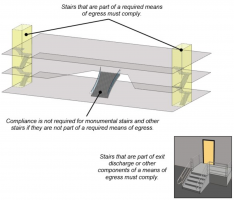Agree... but I'd make note of the exceptions provided in 1009.1. For some reason, I have seen that these can be overlooked.
Also, really appreciate the topic. One aspect that I have seen as a point of confusion frequently is the difference between an accessible means of egress (Sec. 1009) and an accessible route (Sec. 1104). Stairs are a viable component of an accessible means of egress, but obviously are not a component of an accessible route. I see a lot of confusion regarding the two topics. Interested to see if a discussion follows regarding accessible MoE vs. accessible routes.
2021 IBC 1009.1 Accessible Means of Egress Required
Accessible means of egress shall comply with this section. Accessible spaces shall be provided with not less than one accessible means of egress. Where more than one means of egress is required by Section 1006.2 or 1006.3 from any accessible space, each accessible portion of the space shall be served by not less than two accessible means of egress.
Exceptions:
- One accessible means of egress is required from an accessible mezzanine level in accordance with Section 1009.3, 1009.4 or 1009.5.
- In assembly areas with ramped aisles or stepped aisles, one accessible means of egress is permitted where the common path of egress travel is accessible and meets the requirements in Section 1030.8.



